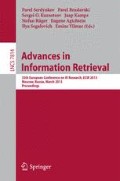Abstract
We present Serelex, a system that provides, given a query in English, a list of semantically related words. The terms are ranked according to an original semantic similarity measure learnt from a huge corpus. The system performs comparably to dictionary-based baselines, but does not require any semantic resource such as WordNet. Our study shows that users are completely satisfied with 70% of the query results.
Access this chapter
Tax calculation will be finalised at checkout
Purchases are for personal use only
Preview
Unable to display preview. Download preview PDF.
References
Panchenko, A., Morozova, O., Naets, H.: A semantic similarity measure based on lexico-syntactic patterns. In: Proceedings of KONVENS 2012, pp. 174–178 (2012)
Baroni, M., Bernardini, S., Ferraresi, A., Zanchetta, E.: The wacky wide web: A collection of very large linguistically processed web-crawled corpora. LREC 43(3), 209–226 (2009)
Barnes, J., Hut, P.: A hierarchical 0 (n log iv) force-calculation algorithm. Nature 324, 4 (1986)
Wu, Z., Palmer, M.: Verbs semantics and lexical selection. In: ACL 1994, pp. 133–138 (1994)
Leacock, C., Chodorow, M.: Combining Local Context and WordNet Similarity for Word Sense Identification. In: WordNet, pp. 265–283 (1998)
Resnik, P.: Using Information Content to Evaluate Semantic Similarity in a Taxonomy. In: IJCAI, vol. 1, pp. 448–453 (1995)
Banerjee, S., Pedersen, T.: Extended gloss overlaps as a measure of semantic relatedness. In: IJCAI, vol. 18, pp. 805–810 (2003)
Patwardhan, S., Pedersen, T.: Using WordNet-based context vectors to estimate the semantic relatedness of concepts. In: Making Sense of Sense: Bringing Psycholinguistics and Computational Linguistics Together, pp. 1–12 (2006)
Zesch, T., Müller, C., Gurevych, I.: Extracting lexical semantic knowledge from wikipedia and wiktionary. In: LREC 2008, pp. 1646–1652 (2008)
Van de Cruys, T.: Mining for Meaning: The Extraction of Lexico-Semantic Knowledge from Text. PhD thesis, University of Groningen (2010)
Author information
Authors and Affiliations
Editor information
Editors and Affiliations
Rights and permissions
Copyright information
© 2013 Springer-Verlag Berlin Heidelberg
About this paper
Cite this paper
Panchenko, A. et al. (2013). Serelex: Search and Visualization of Semantically Related Words. In: Serdyukov, P., et al. Advances in Information Retrieval. ECIR 2013. Lecture Notes in Computer Science, vol 7814. Springer, Berlin, Heidelberg. https://doi.org/10.1007/978-3-642-36973-5_97
Download citation
DOI: https://doi.org/10.1007/978-3-642-36973-5_97
Publisher Name: Springer, Berlin, Heidelberg
Print ISBN: 978-3-642-36972-8
Online ISBN: 978-3-642-36973-5
eBook Packages: Computer ScienceComputer Science (R0)

